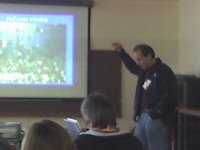Main Menu
Welcome
NO synthase is only expressed in few neurons in the buccal ganglia and only some neurons express guanylate cyclase. This suggests that not all neurons respond equally to NO signaling. NO signaling in turn takes place locally at the growth cone. This was shown by applying NO only to one of several growth cones of a single neuron and leading to filopodial elongation only in this growth cone. The NO effects were suggested to be physiological by showing the filopodial elongation occurred in response to a single neuron producing NO close to the growth cone. The distance to the growth cone needs to be at least 100 microns or less.
NO application also depolarizes the membrane potential and stimulates spiking activity in the neurons. Any spikes produced after the NO increase are slightly broadened. This is mediated in part by NO decreasing a slow-activating outward current.

Posted on Thursday 07 June 2007 - 18:00:40 comment: 0
{TAGS}
{TAGS}
You must be logged in to make comments on this site - please log in, or if you are not registered click here to signup
Render time: 0.0603 sec, 0.0061 of that for queries.





